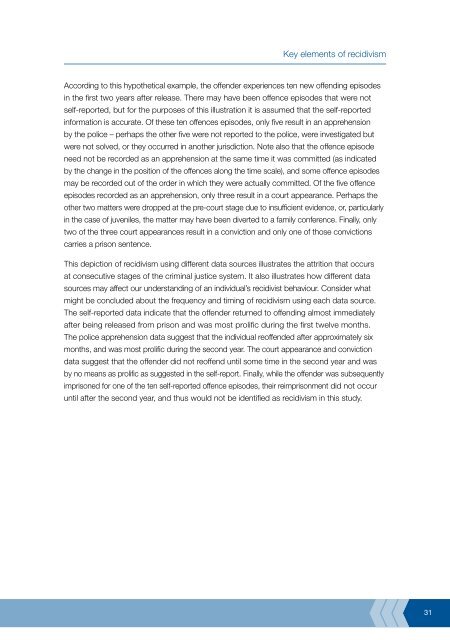Recidivism in Australia : findings and future research - Australian ...
Recidivism in Australia : findings and future research - Australian ...
Recidivism in Australia : findings and future research - Australian ...
Create successful ePaper yourself
Turn your PDF publications into a flip-book with our unique Google optimized e-Paper software.
Key elements of recidivism<br />
Accord<strong>in</strong>g to this hypothetical example, the offender experiences ten new offend<strong>in</strong>g episodes<br />
<strong>in</strong> the first two years after release. There may have been offence episodes that were not<br />
self-reported, but for the purposes of this illustration it is assumed that the self-reported<br />
<strong>in</strong>formation is accurate. Of these ten offences episodes, only five result <strong>in</strong> an apprehension<br />
by the police – perhaps the other five were not reported to the police, were <strong>in</strong>vestigated but<br />
were not solved, or they occurred <strong>in</strong> another jurisdiction. Note also that the offence episode<br />
need not be recorded as an apprehension at the same time it was committed (as <strong>in</strong>dicated<br />
by the change <strong>in</strong> the position of the offences along the time scale), <strong>and</strong> some offence episodes<br />
may be recorded out of the order <strong>in</strong> which they were actually committed. Of the five offence<br />
episodes recorded as an apprehension, only three result <strong>in</strong> a court appearance. Perhaps the<br />
other two matters were dropped at the pre-court stage due to <strong>in</strong>sufficient evidence, or, particularly<br />
<strong>in</strong> the case of juveniles, the matter may have been diverted to a family conference. F<strong>in</strong>ally, only<br />
two of the three court appearances result <strong>in</strong> a conviction <strong>and</strong> only one of those convictions<br />
carries a prison sentence.<br />
This depiction of recidivism us<strong>in</strong>g different data sources illustrates the attrition that occurs<br />
at consecutive stages of the crim<strong>in</strong>al justice system. It also illustrates how different data<br />
sources may affect our underst<strong>and</strong><strong>in</strong>g of an <strong>in</strong>dividual’s recidivist behaviour. Consider what<br />
might be concluded about the frequency <strong>and</strong> tim<strong>in</strong>g of recidivism us<strong>in</strong>g each data source.<br />
The self-reported data <strong>in</strong>dicate that the offender returned to offend<strong>in</strong>g almost immediately<br />
after be<strong>in</strong>g released from prison <strong>and</strong> was most prolific dur<strong>in</strong>g the first twelve months.<br />
The police apprehension data suggest that the <strong>in</strong>dividual reoffended after approximately six<br />
months, <strong>and</strong> was most prolific dur<strong>in</strong>g the second year. The court appearance <strong>and</strong> conviction<br />
data suggest that the offender did not reoffend until some time <strong>in</strong> the second year <strong>and</strong> was<br />
by no means as prolific as suggested <strong>in</strong> the self-report. F<strong>in</strong>ally, while the offender was subsequently<br />
imprisoned for one of the ten self-reported offence episodes, their reimprisonment did not occur<br />
until after the second year, <strong>and</strong> thus would not be identified as recidivism <strong>in</strong> this study.<br />
31















